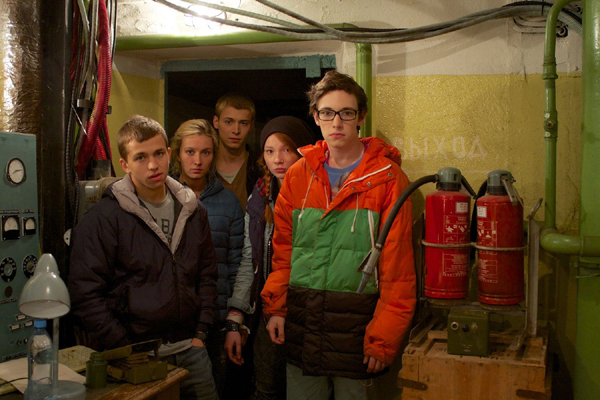Revisiting chernobyl
|
 Russian drama series Chernobyl: The Exclusion Zone centers on five Moscow teenagers on a road trip to Pripyat, the nuclear plant workers' town evacuated after the 1986 disaster. Agence France-Presse |
A new teen TV series evokes horrors of the nuclear disaster, Anna Malpas reports from Moscow.
A group of teenagers wanders through abandoned classrooms, clambers up a rusted wheel and stands on the roof of an apartment block topped with political slogans.
The eerie scenes come from Chernobyl: The Exclusion Zone, a new Russian teen drama that retells the 1986 story to a generation with no memories of the world's worst civilian nuclear disaster.
Using lavish computer-generated imagery rarely seen on Russian television, the show airing from this month follows a group of teenagers on a road trip to Pripyat, the nuclear plant workers' town evacuated after the disaster.
The series of eight spooky, hour-long episodes was made by TNT, a youth-oriented channel aimed at an 18-to 30-year-old audience that normally airs standup comedy, sitcoms and reality shows.
"I wanted to tell the story of this to an audience ... that doesn't have such a personal sense of empathy," says co-writer and producer Yevgeny Nikishov, himself only 7 when the accident occurred.
A nuclear explosion triggered by a test shutdown led to radioactive fallout being carried by winds over northern neighbor Belarus and as far as Western Europe, in a disaster initially covered up by former Soviet authorities.
While only two people were killed in the blast, 28 rescue workers died of radiation in the following three months, the UN nuclear agency says. And more than 25,000 cleanup workers, known as "liquidators", have died since the disaster, according to official Ukrainian figures.
But the true scale of the death toll directly attributable to the disaster remains the subject of bitter scientific debate.
The story of the man-made disaster has had a huge influence on popular culture and legends have grown up about the exclusion zone around the plant, which has been left to grow wild since 1986, becoming a kind of open-air museum to the late Soviet era.
A subculture of extreme thrill-seekers explores the area and artists have graffitied the buildings with child-like figures, as seen in the show.
Viewers see footage filmed in the ghost town of Pripyat, 110 kilometers from Kiev, where radiation levels are still high and authorities control access to the overgrown streets.
The story centers on five Moscow teenagers who set off to Chernobyl together, their motivations varying from stolen money to family secrets - or just the chance of "getting lucky".
"If you go, maybe you won't be a virgin any more," one of the teenage girls, Anya, whispers to nerdy Gosha, who promptly steals his grandfather's Volga car for the trip.
Teenagers at a gala screening at a Moscow cinema admitted they knew little about Chernobyl.
"There was a nuclear explosion - that's all (I know)," says 13-year-old Nikita, bursting out laughing.
He says he enjoyed the episodes in Pripyat but found the buildup "boring", adding: "You could see where they used computer graphics."
The makers also slip in nuggets of history.
"We don't stuff you with historical facts - first this happened, then that - you just find out things through us," says actress Kristina Kazinskaya, who plays one of the teenagers.
In one scene, the gang's leader, Pasha, emotionally recounts how locals, not realizing the seriousness of the accident, gathered to watch the fire at the plant.
"They just stood on the bridge and watched and the wind blew tons of radioactive fuel at them," he says.
In another scene that rings true for teens, Gosha calmly snaps pictures on his iPad as they visit an abandoned school.
Pripyat was the setting for a popular video game S.T.A.L.K.E.R. developed in Ukraine, while film director Alexander Mindadze's Innocent Saturday in 2012 recounts the story of people trying to escape after the explosion.
The show's makers argued that it is not disrespectful to those who died or the horrific scale of the accident.
"I think we treated the real parts of this story with huge attention and deference," says Alexander Dulerain, TNT channel's chief producer.
And it was not intended to be a documentary, writer Nikishov stresses.
"The film's not about the real problems, the social problems of the disaster at the nuclear power station.
"It's more about the image of Chernobyl in people's heads."


















